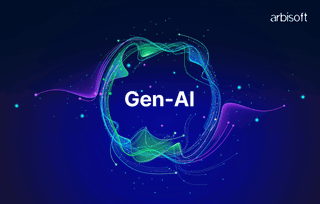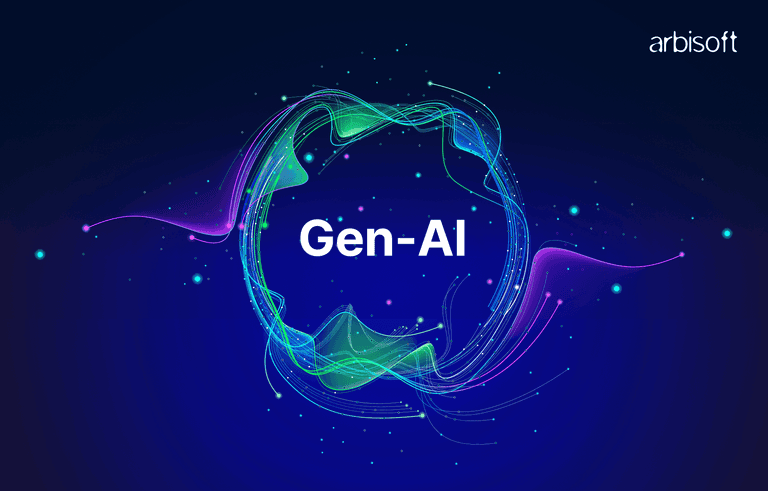We put excellence, value and quality above all - and it shows




A Technology Partnership That Goes Beyond Code

“Arbisoft has been my most trusted technology partner for now over 15 years. Arbisoft has very unique methods of recruiting and training, and the results demonstrate that. They have great teams, great positive attitudes and great communication.”
Is Web Content Accessibility Key to Business Success?

Did you know that there's a set of guidelines to ensure your web content is accessible to everyone? It's called WCAG, which stands for Web Content Accessibility Guidelines. These guidelines are like a rulebook created by the World Wide Web Consortium (W3C) to make sure websites are usable for all, including those with disabilities. The World Wide Web Consortium suggests using WCAG 2.2 to ensure your websites are as accessible as possible.
These guidelines are crucial as they help developers make websites that work well for everyone, no matter their abilities. They cover things like making text easy to read, providing captions for videos, and making websites work with screen readers for people who are blind; conducting accessibility testing can further ensure these features remain effective.
The Importance of Web Accessibility for a Fair and Inclusive Digital World
Websites are how businesses showcase themselves to the world, and that means making them accessible to everyone, everywhere. Website accessibility is important due to the large number of people with disabilities. According to the World Health Organization (WHO) and the Centers for Disease Control and Prevention (CDC):
- 16% of the world's population has a disability. That’s over 1 billion people worldwide.
- 26% of the U.S. population have a disability, which is around 86 million people in the U.S.
These disabilities can include physical, sensory, cognitive, and intellectual challenges. When websites are not designed to be accessible, these individuals may find it hard or even impossible to use them. This means that a large number of people could be left out from accessing information, services, and opportunities online.
By following accessible website development best practices, we ensure that everyone, regardless of their abilities, can navigate, understand, and use web content. This is essential for creating a fair digital world where all users have equal access to the benefits of the internet.
Looking to Comply With WCAG 2.2?
Here's Your Complete Accessibility Checklist!

Download the Complete Guide here
Do you want your website to be compliant with WCAG 2.2?

Why is Web Content Accessibility Essential for Business Success?
Beyond legal and economic motives, prioritizing web accessibility is inherently beneficial for your business. By upholding principles of equity, dignity, and respect, it ensures inclusive engagement for all users, regardless of their special needs.
1. Inclusivity and Equal Access
The Internet is a fundamental part of daily life, from shopping and banking to learning and entertainment. For people with disabilities, accessing the web without barriers is essential for equal participation in society.
For example, a visually impaired person using a screen reader should be able to navigate a website and access all its information just as easily as a sighted person. This means including alt text for images and ensuring that buttons and links are properly labeled. A person with hearing impairments should be able to watch videos with captions so he can follow along with the spoken content.
2. Legal Compliance
Many countries have laws and regulations requiring web accessibility. For instance:
The Americans with Disabilities Act (ADA) in the U.S. and the European Accessibility Act in the EU mandate web accessibility, ensuring that digital spaces are accessible to everyone. In Canada, the Accessibility for Ontarians with Disabilities Act (AODA) requires businesses to make their websites accessible to people with disabilities. Similarly, in Australia – The Disability Discrimination Act (DDA) requires equal access for people with disabilities. Non-compliance can result in legal actions, fines, and reputational damage.
3. Corporate Social Responsibility (CSR)
The display of a commitment to accessibility is a positive reflection of a company’s values and ethics. It shows that a business is dedicated to inclusivity and equality, which can enhance its public image.
A company that prioritizes accessibility may be seen as more socially responsible, attracting customers and employees who value inclusivity. According to Creature&CO, in a global survey, 72% of Gen Z-ers are willing to pay more for products that come from companies with strong CSR initiatives, along with 51% of baby boomers.
4. Competitive Advantage
Being a leader in accessibility can set a business apart from competitors. This not only enhances the brand image but also attracts a loyal customer base that appreciates the company's commitment to accessibility and inclusivity. In 2021, Nike unveiled its "Nike FlyEase" line of footwear, which features innovative designs aimed at improving accessibility for individuals with disabilities.
By prioritizing accessibility, Nike has not only differentiated itself from competitors but also strengthened its connection with consumers, ultimately driving growth and fostering a more inclusive society.
5. Improved User Experience
Accessibility features often enhance the overall user experience for everyone, not just those with disabilities, and integrating ux design services can further refine and personalize user interactions. Good design benefits all users by making content more readable, navigable, and usable.
High-contrast text, which is crucial for users with visual impairments, also helps people in bright sunlight or with low vision due to aging. Also, clear and simple navigation menus benefit everyone by making it easier to find information quickly.
6. Employee Productivity and Morale
An accessible internal website or intranet can help employees with disabilities perform their tasks more efficiently, boosting their productivity. When employees feel supported by their workplace's digital tools, their job satisfaction and productivity increase. This can lead to higher employee retention rates and a more inclusive workplace culture, attracting top talent who value diversity and inclusivity.
7. Driving Innovation
In 2021, Microsoft introduced the "Immersive Reader" feature across its suite of productivity tools, including Microsoft Word, OneNote, Outlook, and Teams. The Immersive Reader utilizes advanced text-to-speech and dyslexia-friendly fonts to improve reading comprehension and accessibility for users with dyslexia, ADHD, or visual impairments.
This underscores the importance of considering accessibility as a driver of innovation, rather than just a compliance requirement. Companies that embrace accessible design principles are better positioned to identify and capitalize on opportunities for innovation, ultimately driving growth and creating positive social impact.
8. Increased Market Reach
Expanding accessibility not only ensures inclusivity but also broadens your market reach in several ways. By making your website accessible to people with disabilities, you tap into a sizable segment of the population that might have been previously overlooked. This demographic includes individuals with various impairments, such as motor disabilities, visual or auditory impairments, cognitive challenges, and more.
Consider a scenario where an online store optimizes its website for keyboard navigation. This simple adjustment caters to individuals who may have difficulty using a mouse due to motor disabilities. By ensuring smooth navigation via keyboard commands, you not only enhance the user experience for this specific group but also encourage their engagement with your platform. Consequently, you increase the likelihood of converting these visitors into loyal customers.
Moreover, accessible design doesn't just benefit those with disabilities; it often improves the overall user experience for all visitors. For example, implementing clear and concise labeling benefits not only users with visual impairments who rely on screen readers but also users browsing in noisy environments or on small screens.
9. SEO Benefits
Accessible websites often follow best practices for SEO, such as proper use of headings, alt text for images, and clear navigation. Improving web accessibility can enhance search engine rankings, driving more organic traffic to the website. This can lead to increased visibility, more visitors, and ultimately higher sales.
Pinterest introduced new accessibility features to improve the user experience for individuals with visual impairments. These features included enhanced image descriptions, keyboard navigation enhancements, and improved screen reader compatibility, making the platform more accessible to users with disabilities. Pinterest's implementation of accessibility features not only improves the platform's usability for users with disabilities but also enhances its search engine optimization.
10. Future-Proofing
As technology evolves, adhering to accessibility guidelines ensures that your website remains usable across new devices and platforms. It prepares your site for future updates and innovations. A website designed with accessibility in mind will work well on a variety of devices, and utilizing web development services can help build a robust, accessible platform for all users, including future technologies like new types of screen readers or voice-controlled interfaces. Also, as new regulations and standards emerge, an accessible website will require fewer updates to remain compliant.
Risks vs. Rewards: Examining the Consequences of Ignoring Web Accessibility
1. Exclusion of Potential Customers
If an online educational platform doesn't include closed captions or transcripts for its video lectures, students who are deaf or hard of hearing cannot fully engage with the content, hindering their learning experience and academic performance.
Businesses frequently overlook a substantial market segment, including individuals with hearing impairments who seek accessible educational resources. In the U.S., approximately 15% of adults report some degree of hearing difficulty. Ignoring this demographic not only leads to missed opportunities to attract students who prioritize accessibility but also results in revenue loss and limited market expansion.
Similarly, disregarding the significant purchasing power of people with disabilities, who collectively possess over $490 billion in disposable income in the U.S., represents a missed opportunity for businesses to tap into a lucrative market segment.
2. Legal Risks
In recent years, numerous businesses have faced lawsuits for failing to make their websites accessible to people with disabilities. For instance, in 2019, Winn-Dixie was sued because its website was not accessible to blind users. The court ruled that the website violated the Americans with Disabilities Act (ADA), leading to significant legal consequences for the company.
Not following accessibility laws can result in hefty fines, legal costs, and damage to your reputation. As laws become stricter, businesses face increasing legal risks if they don’t comply. Many companies have had to pay large settlements and invest heavily in fixing their websites to avoid further legal trouble.
3. Reputation Damage
Social media and online reviews can quickly highlight if a business’s website is not accessible. This can lead to negative feedback and public criticism.
Domino's Pizza faced significant criticism and legal challenges when a blind customer filed a lawsuit against them in 2016, alleging that their website and mobile app were not accessible to visually impaired users. The case escalated to the U.S. Supreme Court, which in 2019 declined to hear Domino's appeal, effectively upholding the lower court's decision that the ADA applies to websites and mobile apps.
This legal battle brought a lot of negative attention to Domino's, with many disability rights advocates criticizing the company's lack of accessibility. The public criticism on social media and online reviews highlighted the importance of digital accessibility, leading to damage to Domino's reputation. The case emphasized the need for companies to prioritize accessibility to avoid legal risks and maintain a positive public image.
A bad reputation can scare away potential customers and erode trust with existing ones. It can also hurt partnerships with organizations that value accessibility. According to Creature&Co, 64% of consumers choose, switch, avoid, or boycott a brand based on its stand on societal issues.
4. Reduced Usability
Bookseller Barnes & Noble faced a class action lawsuit in 2022 when a person alleged that the Barnes & Noble website was not fully compatible with the screen-reading software he used to navigate it. He argued that Barnes & Noble denied him equal access to its goods and services by denying him full access to its website. Poor usability affects everyone’s experience, leading to lower sales, higher bounce rates, and less engagement.
5. Challenges in International Expansion
Ignoring accessibility standards can limit a business’s ability to grow globally. Non-compliance can lead to fines, bans, and exclusion from profitable international markets. For instance, in 2021, the popular video conferencing platform Zoom faced backlash in the United States when disability rights advocates filed a lawsuit alleging that Zoom's virtual events and meetings were inaccessible to people with disabilities. This case underscored the importance of accessibility in digital platforms, especially in the context of remote work and online events, and highlighted the legal risks associated with non-compliance with accessibility regulations on a global scale.
6. Hindrance to Partnerships and Collaborations
In international business, particularly when engaging with clients from diverse geographical backgrounds, overlooking accessibility standards can inadvertently sabotage potential partnerships. Consider the scenario where a company, eager to expand its global reach, overlooks the importance of accessibility guidelines in the countries where its clients operate. This oversight not only demonstrates a lack of attention to detail but also risks creating a negative impression among partners who prioritize inclusivity.
Companies that prioritize accessibility, on the other hand, are better equipped to cultivate meaningful partnerships. By demonstrating a commitment to inclusivity, they signal their readiness to engage with a wide array of stakeholders. This proactive approach not only fosters goodwill but also opens doors to strategic collaborations that might otherwise be inaccessible.
7. Missed Opportunities for Innovation
When companies don't make their products easy to use for everyone, they miss chances to come up with new features. These features could make their products better and help them grow. For example, consider a fitness app that includes customizable font sizes and high-contrast color schemes, catering to users with visual impairments or color vision deficiencies. By incorporating these accessibility features, the app becomes more inclusive, ensuring that individuals of all abilities can engage with it comfortably. This not only expands the app's user base but also reinforces the company's commitment to diversity and inclusivity in technology.
As the demand for accessible solutions continues to grow, companies that lead with accessibility meet the evolving needs of diverse users and set new standards for innovation in the industry.
Winding Up
In conclusion, these examples illustrate the significance of understanding and addressing web content accessibility issues for businesses. By integrating accessibility into their strategies, companies can ensure inclusivity, legal compliance, a positive reputation, better usability, and sustainable growth in today’s digital world. From the risks associated with non-compliance to the opportunities presented by prioritizing accessibility, the experiences of major companies provide valuable insights for organizations looking to navigate the complexities of web accessibility. By learning from these examples, businesses can not only mitigate potential risks but also capitalize on the benefits of creating more accessible and inclusive digital experiences for all users.
Ready to enhance your website's accessibility? Get in touch with us at contact@arbisoft.com, and let's make your digital space inclusive together!
























